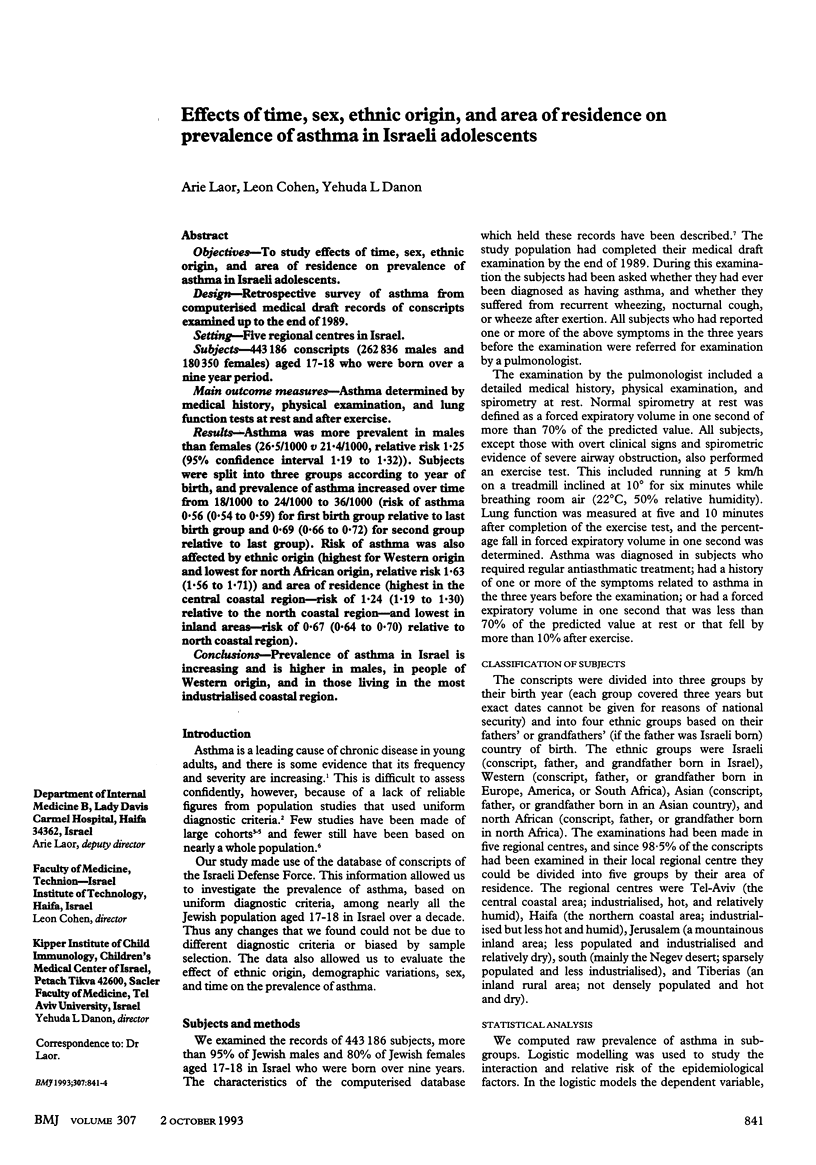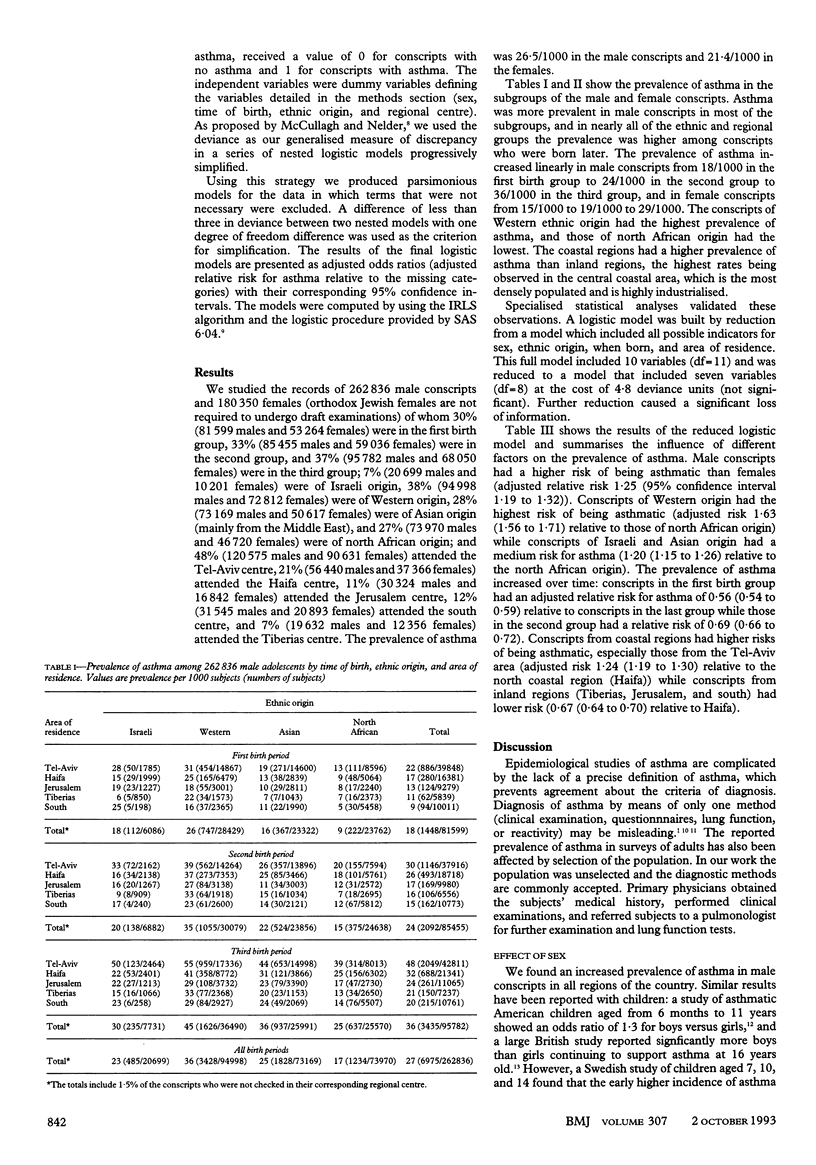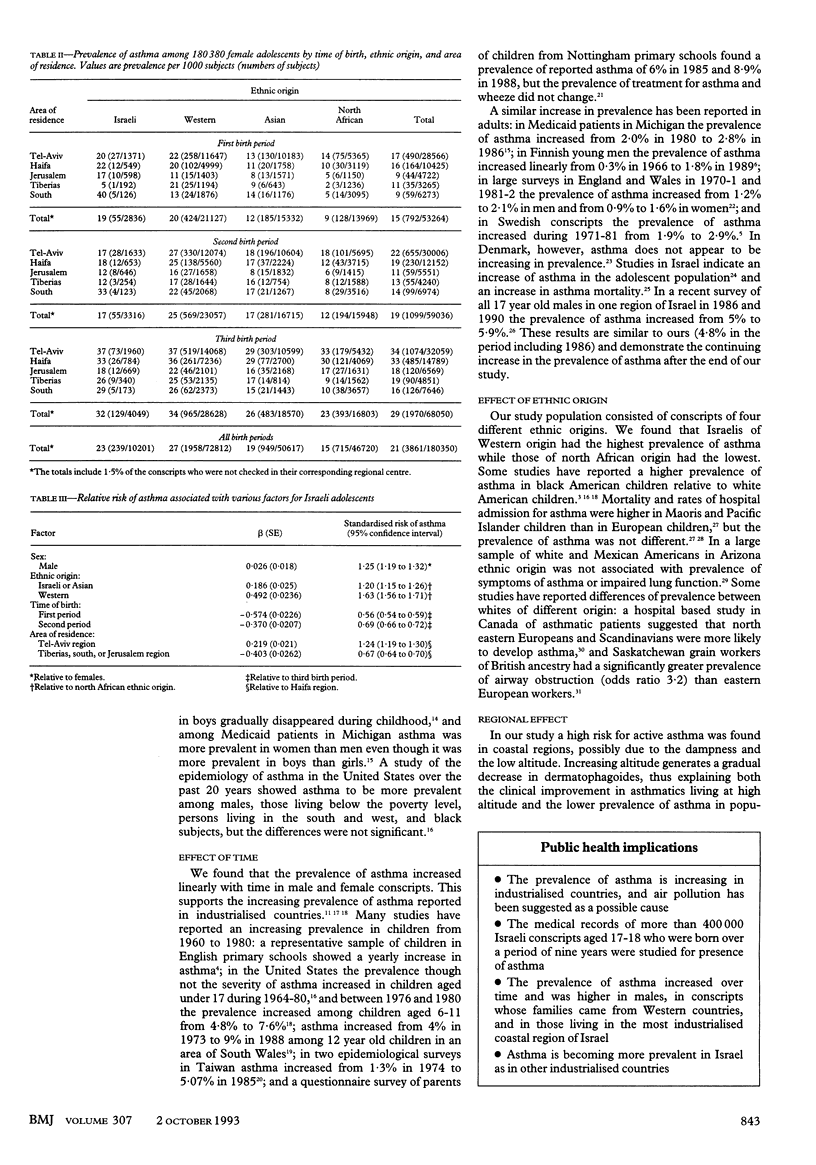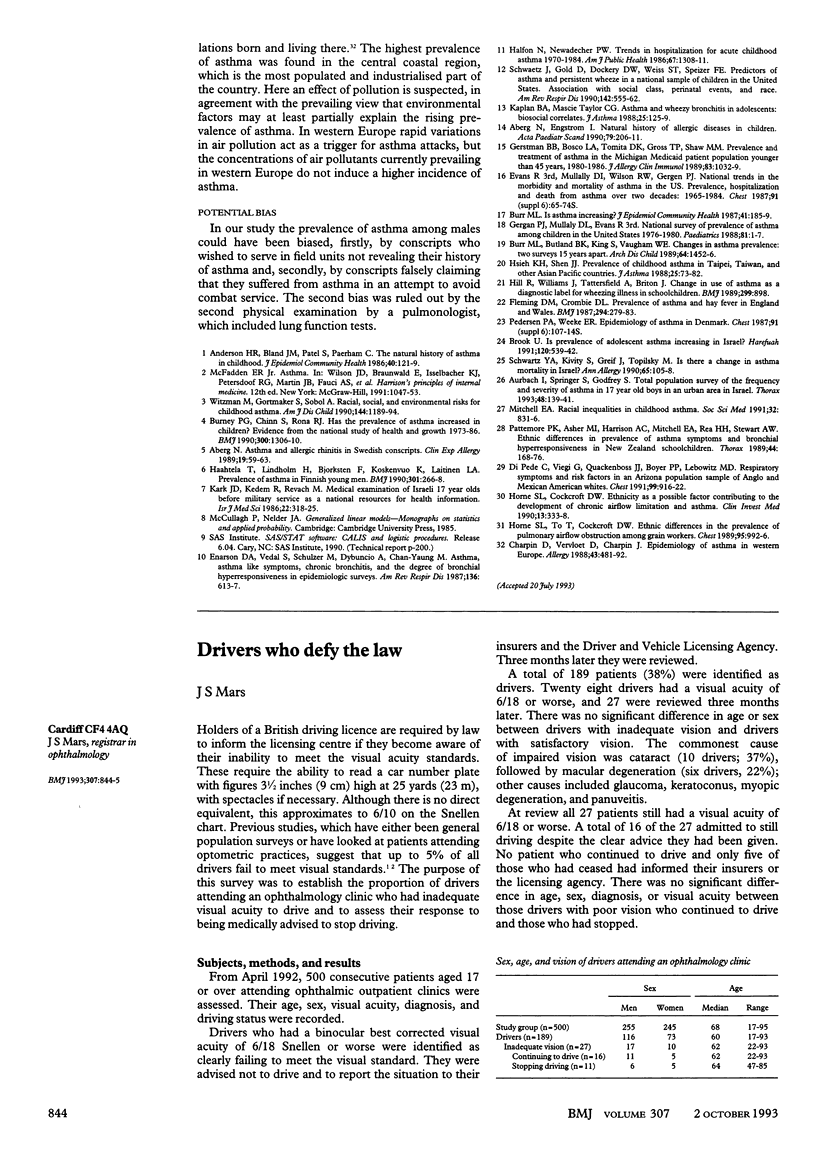Abstract
OBJECTIVES--To study effects of time, sex, ethnic origin, and area of residence on prevalence of asthma in Israeli adolescents. DESIGN--Retrospective survey of asthma from computerised medical draft records of conscripts examined up to the end of 1989. SETTING--Five regional centres in Israel. SUBJECTS--443 186 conscripts (262 836 males and 180 350 females) aged 17-18 who were born over a nine year period. MAIN OUTCOME MEASURES--Asthma determined by medical history, physical examination, and lung function tests at rest and after exercise. RESULTS--Asthma was more prevalent in males than females (26.5/1000 v 21.4/1000, relative risk 1.25 (95% confidence interval 1.19 to 1.32)). Subjects were split into three groups according to year of birth, and prevalence of asthma increased over time from 18/1000 to 24/1000 to 36/1000 (risk of asthma 0.56 (0.54 to 0.59) for first birth group relative to last birth group and 0.69 (0.66 to 0.72) for second group relative to last group). Risk of asthma was also affected by ethnic origin (highest for Western origin and lowest for north African origin, relative risk 1.63 (1.56 to 1.71)) and area of residence (highest in the central coastal region--risk of 1.24 (1.19 to 1.30) relative to the north coastal region--and lowest in inland areas--risk of 0.67 (0.64 to 0.70) relative to north coastal region). CONCLUSIONS--Prevalence of asthma in Israel is increasing and is higher in males, in people of Western origin, and in those living in the most industrialised coastal region.
Full text
PDF



Selected References
These references are in PubMed. This may not be the complete list of references from this article.
- Aberg N. Asthma and allergic rhinitis in Swedish conscripts. Clin Exp Allergy. 1989 Jan;19(1):59–63. doi: 10.1111/j.1365-2222.1989.tb02345.x. [DOI] [PubMed] [Google Scholar]
- Aberg N., Engström I. Natural history of allergic diseases in children. Acta Paediatr Scand. 1990 Feb;79(2):206–211. doi: 10.1111/j.1651-2227.1990.tb11440.x. [DOI] [PubMed] [Google Scholar]
- Anderson H. R., Bland J. M., Patel S., Peckham C. The natural history of asthma in childhood. J Epidemiol Community Health. 1986 Jun;40(2):121–129. doi: 10.1136/jech.40.2.121. [DOI] [PMC free article] [PubMed] [Google Scholar]
- Auerbach I., Springer C., Godfrey S. Total population survey of the frequency and severity of asthma in 17 year old boys in an urban area in Israel. Thorax. 1993 Feb;48(2):139–141. doi: 10.1136/thx.48.2.139. [DOI] [PMC free article] [PubMed] [Google Scholar]
- Brook U. [Is childhood asthma and its complications also increasing in Israel?]. Harefuah. 1991 May 1;120(9):539–542. [PubMed] [Google Scholar]
- Burney P. G., Chinn S., Rona R. J. Has the prevalence of asthma increased in children? Evidence from the national study of health and growth 1973-86. BMJ. 1990 May 19;300(6735):1306–1310. doi: 10.1136/bmj.300.6735.1306. [DOI] [PMC free article] [PubMed] [Google Scholar]
- Burr M. L., Butland B. K., King S., Vaughan-Williams E. Changes in asthma prevalence: two surveys 15 years apart. Arch Dis Child. 1989 Oct;64(10):1452–1456. doi: 10.1136/adc.64.10.1452. [DOI] [PMC free article] [PubMed] [Google Scholar]
- Burr M. L. Is asthma increasing? J Epidemiol Community Health. 1987 Sep;41(3):185–189. doi: 10.1136/jech.41.3.185. [DOI] [PMC free article] [PubMed] [Google Scholar]
- Charpin D., Vervloet D., Charpin J. Epidemiology of asthma in western Europe. Allergy. 1988 Oct;43(7):481–492. doi: 10.1111/j.1398-9995.1988.tb01624.x. [DOI] [PubMed] [Google Scholar]
- Di Pede C., Viegi G., Quackenboss J. J., Boyer-Pfersdorf P., Lebowitz M. D. Respiratory symptoms and risk factors in an Arizona population sample of Anglo and Mexican-American whites. Chest. 1991 Apr;99(4):916–922. doi: 10.1378/chest.99.4.916. [DOI] [PubMed] [Google Scholar]
- Enarson D. A., Vedal S., Schulzer M., Dybuncio A., Chan-Yeung M. Asthma, asthmalike symptoms, chronic bronchitis, and the degree of bronchial hyperresponsiveness in epidemiologic surveys. Am Rev Respir Dis. 1987 Sep;136(3):613–617. doi: 10.1164/ajrccm/136.3.613. [DOI] [PubMed] [Google Scholar]
- Fleming D. M., Crombie D. L. Prevalence of asthma and hay fever in England and Wales. Br Med J (Clin Res Ed) 1987 Jan 31;294(6567):279–283. doi: 10.1136/bmj.294.6567.279. [DOI] [PMC free article] [PubMed] [Google Scholar]
- Gergen P. J., Mullally D. I., Evans R., 3rd National survey of prevalence of asthma among children in the United States, 1976 to 1980. Pediatrics. 1988 Jan;81(1):1–7. [PubMed] [Google Scholar]
- Gerstman B. B., Bosco L. A., Tomita D. K., Gross T. P., Shaw M. M. Prevalence and treatment of asthma in the Michigan Medicaid patient population younger than 45 years, 1980-1986. J Allergy Clin Immunol. 1989 Jun;83(6):1032–1039. doi: 10.1016/0091-6749(89)90444-2. [DOI] [PubMed] [Google Scholar]
- Haahtela T., Lindholm H., Björkstén F., Koskenvuo K., Laitinen L. A. Prevalence of asthma in Finnish young men. BMJ. 1990 Aug 4;301(6746):266–268. doi: 10.1136/bmj.301.6746.266. [DOI] [PMC free article] [PubMed] [Google Scholar]
- Halfon N., Newacheck P. W. Trends in the hospitalization for acute childhood asthma, 1970-84. Am J Public Health. 1986 Nov;76(11):1308–1311. doi: 10.2105/ajph.76.11.1308. [DOI] [PMC free article] [PubMed] [Google Scholar]
- Hill R., Williams J., Tattersfield A., Britton J. Change in use of asthma as a diagnostic label for wheezing illness in schoolchildren. BMJ. 1989 Oct 7;299(6704):898–898. doi: 10.1136/bmj.299.6704.898. [DOI] [PMC free article] [PubMed] [Google Scholar]
- Horne S. L., Cockcroft D. W. Ethnicity as a possible factor contributing to the development of chronic airflow limitation and asthma. Clin Invest Med. 1990 Dec;13(6):333–338. [PubMed] [Google Scholar]
- Horne S. L., To T., Cockcroft D. W. Ethnic differences in the prevalence of pulmonary airflow obstruction among grain workers. Chest. 1989 May;95(5):992–996. doi: 10.1378/chest.95.5.992. [DOI] [PubMed] [Google Scholar]
- Hsieh K. H., Shen J. J. Prevalence of childhood asthma in Taipei, Taiwan, and other Asian Pacific countries. J Asthma. 1988;25(2):73–82. doi: 10.3109/02770908809071357. [DOI] [PubMed] [Google Scholar]
- Kaplan B. A., Mascie-Tayor C. G. Asthma and wheezy bronchitis in adolescents: biosocial correlates. J Asthma. 1988;25(3):125–129. doi: 10.3109/02770908809073199. [DOI] [PubMed] [Google Scholar]
- Kark J. D., Kedem R., Revach M. Medical examination of Israeli 17-year-olds before military service as a national resource for health information. Isr J Med Sci. 1986 Mar-Apr;22(3-4):318–325. [PubMed] [Google Scholar]
- Mitchell E. A. Racial inequalities in childhood asthma. Soc Sci Med. 1991;32(7):831–836. doi: 10.1016/0277-9536(91)90309-z. [DOI] [PubMed] [Google Scholar]
- Pattemore P. K., Asher M. I., Harrison A. C., Mitchell E. A., Rea H. H., Stewart A. W. Ethnic differences in prevalence of asthma symptoms and bronchial hyperresponsiveness in New Zealand schoolchildren. Thorax. 1989 Mar;44(3):168–176. doi: 10.1136/thx.44.3.168. [DOI] [PMC free article] [PubMed] [Google Scholar]
- Schwartz J., Gold D., Dockery D. W., Weiss S. T., Speizer F. E. Predictors of asthma and persistent wheeze in a national sample of children in the United States. Association with social class, perinatal events, and race. Am Rev Respir Dis. 1990 Sep;142(3):555–562. doi: 10.1164/ajrccm/142.3.555. [DOI] [PubMed] [Google Scholar]
- Schwartz Y. A., Kivity S., Greif J., Topilsky M. Is there a change in asthma mortality in Israel? Ann Allergy. 1990 Aug;65(2):105–108. [PubMed] [Google Scholar]
- Weitzman M., Gortmaker S., Sobol A. Racial, social, and environmental risks for childhood asthma. Am J Dis Child. 1990 Nov;144(11):1189–1194. doi: 10.1001/archpedi.1990.02150350021016. [DOI] [PubMed] [Google Scholar]


